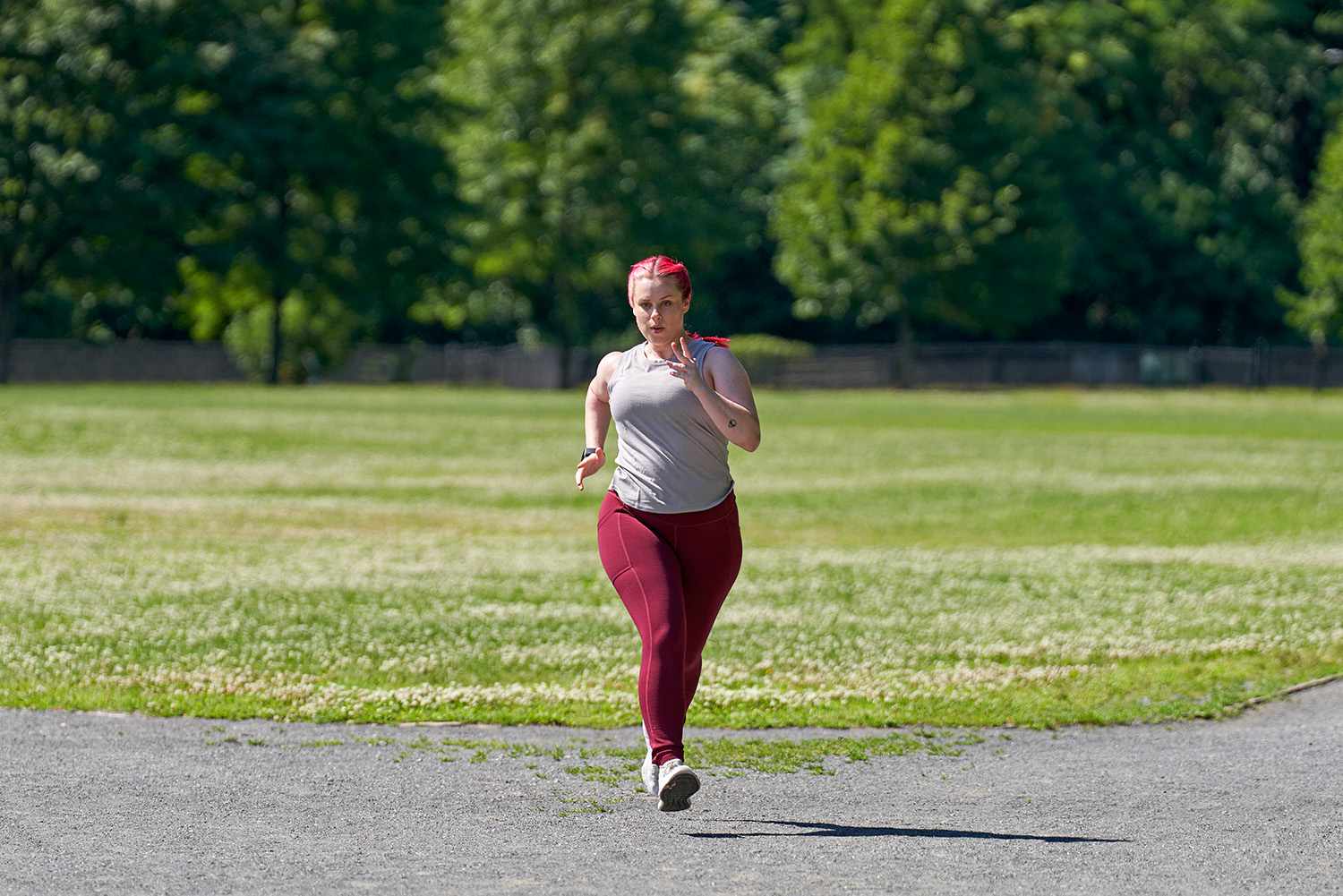

Featured
How Many Steps Jogging A Mile
Modified: August 21, 2023
Discover how many steps are required to jog a mile with this featured guide. Get insights and tips on calculating your stride length and achieving your running goals.
Introduction
Welcome to our article on the number of steps needed to jog a mile! Jogging is a popular form of exercise that can improve cardiovascular health, boost endurance, and help in weight loss. However, have you ever wondered how many steps it takes to complete a mile while jogging? In this article, we will explore the factors that affect the number of steps required, as well as provide some tips for efficient jogging.
Before we delve into the details, it’s essential to understand what jogging is and how we measure the distance of a mile. Jogging is a form of running that is done at a slower pace, often accompanied by a steady rhythm of breathing. It is a low-impact exercise that allows individuals of all fitness levels to engage in physical activity.
When it comes to measuring distance, the mile is a common unit used in the United States, United Kingdom, and some other countries. One mile is equivalent to approximately 1.6 kilometers or 5,280 feet. Knowing the distance of a mile is crucial for tracking progress and setting fitness goals.
Now that we have a basic understanding of jogging and the mile, let’s explore the factors that can affect the number of steps required to complete a mile. Keep in mind that the number of steps can vary for different individuals based on various factors such as stride length, running form, terrain, and pace.
Understanding Jogging and Mile
Before we dive into the details of how many steps it takes to jog a mile, let’s first understand the concepts of jogging and the mile itself. Jogging is a form of running that is performed at a slower pace. It is a popular exercise for improving cardiovascular fitness, building endurance, and burning calories.
The mile, on the other hand, is a unit of distance commonly used in the United States and other countries that follow the imperial measurement system. One mile is equivalent to approximately 1.6 kilometers or 5,280 feet. It provides a tangible measure for runners to gauge their progress and set goals, making it a useful benchmark in the world of jogging and running.
Understanding the relationship between jogging and the mile is important because it helps us determine the effort and distance covered during our workout sessions. By knowing the length of a mile, we can measure our performance, track our improvements, and plan our jogging routes accordingly.
When it comes to jogging, it’s essential to find a pace that suits your fitness level and goals. Some individuals prefer a leisurely jog, maintaining a comfortable jogging rhythm that allows them to sustain their activity for an extended period. Others may opt for a more intense pace, pushing themselves to challenge their cardiovascular capacity and improve their speed.
The choice of jogging pace can influence the number of steps required to complete a mile. A slow, relaxed jog may result in a higher number of steps, while a faster and more powerful stride may cover more distance with fewer steps. It’s important to find a pace that feels challenging yet sustainable for your fitness level.
Furthermore, it’s worth noting that jogging on different terrains can affect the number of steps needed to complete a mile. Running on a flat surface, such as a track or a treadmill, allows for a more consistent stride length and reduces the variability in step count. In contrast, jogging on uneven or hilly terrain may require adjustments in stride length and increase the number of steps to cover the same distance.
Now that we have a solid understanding of jogging and the mile, let’s explore the factors that can influence the number of steps required to jog a mile in more detail.
Factors Affecting Number of Steps
The number of steps required to jog a mile can vary from person to person due to several factors. Here are some key factors that can influence the number of steps:
- Stride Length: Stride length refers to the distance covered with each step while running or jogging. Individuals with longer legs generally have a longer stride length, which means they cover more ground with each step. As a result, they may require fewer steps to complete a mile compared to someone with a shorter stride length.
- Running Form: Running form plays a significant role in the efficiency of your stride. Proper running mechanics, such as maintaining an upright posture, engaging your core, and landing midfoot, can help optimize your stride length and reduce the number of steps needed to cover a mile.
- Pace: Your jogging pace also affects the number of steps required. When running at a faster pace, your stride length naturally increases, allowing you to cover more ground with each step. This means you may need fewer steps to jog a mile at a faster pace compared to a slower, more leisurely jog.
- Terrain: The type of terrain you jog on can impact the number of steps needed. Jogging on uneven or hilly surfaces requires adjustments in stride length and often results in a higher step count as you navigate the variations in elevation. Conversely, running on flat ground, such as a track or treadmill, provides a consistent surface and allows for a more efficient stride.
- Fitness Level: Your fitness level can impact the number of steps it takes to jog a mile. As you become more conditioned and improve your cardiovascular endurance, your stride length and efficiency may increase. This can result in a reduced step count as you become more efficient at covering distance with each stride.
It’s important to remember that these factors are not independent of each other, and they can interact to influence the number of steps required to jog a mile. Stride length, running form, pace, terrain, and fitness level all work together to determine the most efficient and effective way for you to jog a mile.
In the next section, we will discuss how to calculate the number of steps you might take to complete a mile based on these factors.
Calculating Steps in a Mile
Calculating the number of steps required to jog a mile can provide insight into your running efficiency and help you track your progress. While it’s challenging to give an exact number, there are methods to estimate the steps you might take to complete a mile based on certain factors.
To calculate steps in a mile, there are a few different approaches you can consider:
- Measure Your Stride Length: Start by measuring your average stride length. Find a flat and stable surface to jog on and mark a starting point. Take a few strides and measure the distance covered by those steps. Divide the total distance by the number of steps to calculate your average stride length. Once you have this value, you can multiply it by the number of strides required to cover a mile, which is approximately 2,000 strides for the average person.
- Use a Fitness Tracker or App: Fitness trackers and running apps often provide step count data, making it easier to estimate the number of steps you take during a jog. These devices use sensors or GPS technology to track your movement and calculate your approximate step count. Bear in mind that accuracy can vary depending on the device or app you use, so it’s helpful to calibrate your settings or consult the manufacturer for more precise information.
- Refer to Research Studies: Various research studies have investigated the average steps taken to complete a mile while jogging. While these numbers may not be applicable to everyone, they can serve as a general guideline. According to a study published in the International Journal of Sports Physiology and Performance, the average number of steps for recreational joggers to complete a mile ranged from 1,900 to 2,500. These values changed based on factors such as stride length, running speed, and fitness level.
It’s important to remember that these calculations are estimates and can vary from person to person. The number of steps you take to jog a mile will depend on your individual stride length, running form, pace, terrain, and fitness level.
By tracking your steps and monitoring your progress over time, you can get a better understanding of your running efficiency and improvement. Additionally, focusing on maintaining proper running mechanics and gradually increasing your fitness level can help you become more efficient in covering distances with fewer steps.
Now that we have explored how to calculate steps in a mile, let’s move on to some tips for efficient jogging.
Tips for Efficient Jogging
Jogging efficiently can help you maximize your performance, reduce the risk of injury, and optimize the number of steps taken to complete a mile. Here are some tips to help you jog more efficiently:
- Warm up and Cool Down: Before starting your jogging session, it’s crucial to warm up your muscles and prepare your body for exercise. Perform dynamic stretches and light cardio activities to increase blood flow to your muscles. Similarly, cooling down with static stretches after your jog can help improve flexibility and prevent muscle soreness.
- Focus on Proper Running Form: Maintaining a proper running form is key to efficient jogging. Keep your posture upright, relax your shoulders, and engage your core muscles. Avoid overstriding, which can cause excessive impact and slow you down. Instead, aim for a midfoot or forefoot strike, as it promotes a more efficient stride and reduces stress on your joints.
- Incorporate Interval Training: Interval training involves alternating periods of high-intensity running with recovery periods of lower intensity. Adding intervals to your jogging routine can improve your cardiovascular fitness, increase your running speed, and enhance your overall endurance. It also challenges your body to adapt and become more efficient in covering distance with fewer steps.
- Gradually Increase Distance and Intensity: To improve efficiency, gradually increase the distance and intensity of your jogging sessions. This gradual progression allows your body to adapt, strengthens your muscles, and improves your cardiovascular fitness. Push yourself to go a little farther or faster each time, but listen to your body and avoid overexertion.
- Include Strength Training: Incorporating strength training exercises into your fitness routine can help improve running economy and overall performance. Focus on exercises that target your lower body, such as squats, lunges, and calf raises, to build strength and power in your leg muscles. Stronger muscles can generate more force with each stride, allowing you to cover more ground with fewer steps.
- Vary Your Terrain: Mixing up your jogging routes and terrain can challenge your body in different ways and improve muscular strength and coordination. Running uphill engages different muscle groups and encourages longer strides, while running downhill can enhance agility and quicken your pace. Adding variety to your training can promote increased efficiency and adaptability in different running conditions.
- Listen to Your Body: Pay attention to any signs of fatigue or discomfort during your jogging sessions. It’s essential to listen to your body and take rest days when needed to avoid overtraining and potential injuries. Adequate rest and recovery allow your muscles and connective tissues to repair and rebuild, ultimately improving your overall running efficiency.
Remember, efficiency is not just about the number of steps taken but also about optimizing your running technique, fitness level, and overall performance. By implementing these tips, you can enhance your jogging efficiency and enjoy the many benefits of this popular form of exercise.
Now that we have explored tips for efficient jogging, let’s conclude this article.
Conclusion
In conclusion, the number of steps required to jog a mile can vary based on several factors such as stride length, running form, pace, terrain, and fitness level. While it is difficult to provide an exact number of steps for everyone, understanding these factors can help you estimate the steps you might take to cover a mile during your jogging sessions.
Jogging is an excellent form of exercise that offers numerous health benefits, including improved cardiovascular fitness, increased endurance, and weight management. By finding a pace that suits your fitness level, maintaining proper running form, and gradually increasing your distance and intensity, you can improve your jogging efficiency and maximize your overall performance.
It’s important to listen to your body, incorporating rest days and recovery periods into your routine to prevent overtraining and potential injuries. Additionally, incorporating strength training, varying your terrain, and implementing interval training techniques can further enhance your running efficiency and overall running experience.
Remember, the number of steps taken to complete a mile is just one aspect of jogging. Focus on enjoying the journey, setting realistic goals, and celebrating your progress along the way. Whether it’s 1,900 steps or 2,500 steps, what matters most is that you are engaging in regular physical activity that benefits your overall health and well-being.
So lace up your running shoes, head outdoors, or hop on the treadmill, and start jogging your way to better health and fitness. Happy jogging!









